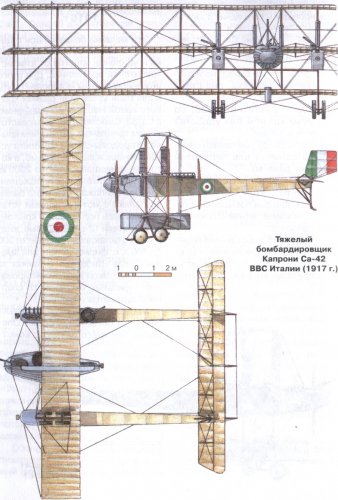Hi Ca.121.
http://alternathistory.com/italyanskie-bumazhnye-proekty-skorostnoi-bombardirovshchik-caproni-ca-121
Auto translation
"RA that in 1932 engineer Gianni Caproni, in collaboration with the engineer Antonio Carati (Antonio Caratti) Ca 121 was a high-speed bomber monoplane. The planned plane was supposed to have a svobodnonesushhee wing and mixed design, included interesting technological solutions, cutting-edge technology and otvechavshuju the most modern technical requirements at the time. Among the distinctive features was elliptical in terms of wing a significant elongation (more than 9), which was typical for both projects developed jointly by Caproni and Karattti and developed Carati yourself.
In addition to the reporting in this article of the aircraft in the period from 1932 to 1934 years they had developed ten projects (all monoplany), some of which have reached the stage of prototype construction. All of them are listed below (note that the abbreviation b and S are, respectively, to the scale and wing surface):
• Ca. 112: Ca. 111 with Wing type Carati (b = 27.7 m, S = 85 m ²);
• Ca 117: high-rise plane (b = 25.6 m, S = 87.5 m ²);
• Ca. 118: Ca. 102 with the wing type Carati (b = 28 m, S = 85 m ²);
• Ca. 120: trehmotornyj bomber, manufactured prototype (b = 27.8 m, S = 92.36 m ²);
• Ca. 122: twin-engined transport aircraft, manufactured prototype (b = 26 m, S = 85 m ²);
• Ca. 123: twin-engined passenger aircraft, a development of Ca. 122, but instead of a V-shaped engines Isotta-Fraschini water-cooling 12R radial engines were installed Gnome-Rhòne 14 West Columbia; manufactured prototype (b = 26 m, S = 85 m ²);
• Ca. 124: single-engined Scout and bomber (b = 19 m, S = 40 m ²) developed both stabilized baht aircraft ground with retractable landing gear and float seaplane version, prototype manufactured in the last configuration;
• Ca. 130: twin-engine seaplane dvuhpoplavkovyj-torpedo bomber with I.F. Asso 750 R.C. (b = 27.86 m, S = 85 m ²);
• Ca. 131: trehmotornyj bomber and colonial transport aircraft with two engines Jupiter IV and a Piaggio Stella IX made prototype (b = 27.9 m, S = 94.62 m ²);
• Ca. 132: trehmotornyj colon industrial transport aircraft with three engines, Piaggio Stella IX R.C., manufactured prototype (b = 27.85 m, S = 85 m ²).
A further characteristic of Ca. 121 was using separate booths for two crew members. This decision, although consistent with placement of foreign aircraft crew in the corresponding destination (u.s. single ground attack aircraft the Curtiss A-8, A-10 and A-12 Shrike and twin-engine bombers Martin (Model 139) B-10, B-12 and B-14, as well as British single Vickers Wellesley bombers) was taken independently and was not an imitation.
To achieve the best possible review forward and down the cockpit was located directly behind the engine at the front edge of the wing, while the Bombardier cab-arrow was located halfway between the rear edge of the wing and tail feathers.
The purpose of this comparison was to use the intermediary space between the two cabins to accommodate different types of bombosbrasyvatelej depending on the types of goals. The second cabin was equipped with a machine gun for protection in the up-back ", while the second, slightly noticeable defensive stance, housed inside the fuselage immediately behind the trailing edge of the wing. The gun was intended to protect aircraft in Gaza "down-back".
It is likely that the planned installation of at least one machine gun (with the same Ammo) in the fuselage, or in one of the parts of the wing-shooting "kill" through the ometanija area of the screw.
Wing profile had to be asymmetric dvojakovypuklym with large relative thickness (26.5% in root parts and 12.5% in endings). The wing was supposed to have a wooden construction with plywood covering.
The power set of the fuselage was to consist of lattice truss made of steel pipes; as a covering aluminum sheets would be used.
Tailplane was supposed to consist of steel tubes, sheeting was to become otlakirovannoe. The stabilizer must have had in-flight adjustable angle of attack.
Powerplant Ca. 121 was supposed to consist of one dvenadcaticilindrovogo the V-shaped engine Isotta Fraschini-cooled Asso XI R.C. Engine had to be equipped with gear and compressor and rotate gyaan Gurung metal screw with adjustable step on Earth and a diameter of 3.3 meters.
CA. 121 was developed in two versions: with neubirajushhimisja the main uprights and radomes chassis with retractable inside the main wing struts with a drive from the cockpit. The second option would significantly improved aircraft aerodynamics and aircraft could provide significant benefits. With equal load of diesel compared to more traditional horizontal speed option would increase to 10%, range-18%, and time-to-height 5000 meters has decreased by about 15% would be. Flight characteristics of the aircraft could be increased by equipping machines more powerful engine (in-line water-cooled) and screw with adjustable in flight, and with constant speed.
Like many other prospective projects concern Caproni bomber, Ca. 121 had not advanced beyond the stage of experimentation with the model 1:23 scale, conducted in August and September 1932 onwards in the Rome Office of research and wind tunnel tests of the Ministry of aviation (Direzione degli Studi e delle Esperienze del Ministero dell'Aeronautica). However, when viewed in the context of the overall review of the level of development of aeronautical engineering of those years, we can say that this project remains an interesting example of the creativity of Italian engineers.
SPECIFICATIONS-SPECIFICATIONS
Type: Caproni Ca 121
Appointment: high-speed bomber
Powerplant:
Isotta Fraschini-type "Asso" XI R.C.
developed power
at sea level-690 HP
at an altitude of 4200 m-840 HP
power, providing a set of height
at sea level-628 HP
at an altitude of 3400 m-755 HP
Dimensions:
wingspan 21.32 m
the total length of 12.087 m
the maximum height of 4.094 m
wing area: 50.5 m ²
lengthening of a wing 9.06
Weight:
empty 2500 kg
payload 2000 kg
total 4500 kg"








































































































































